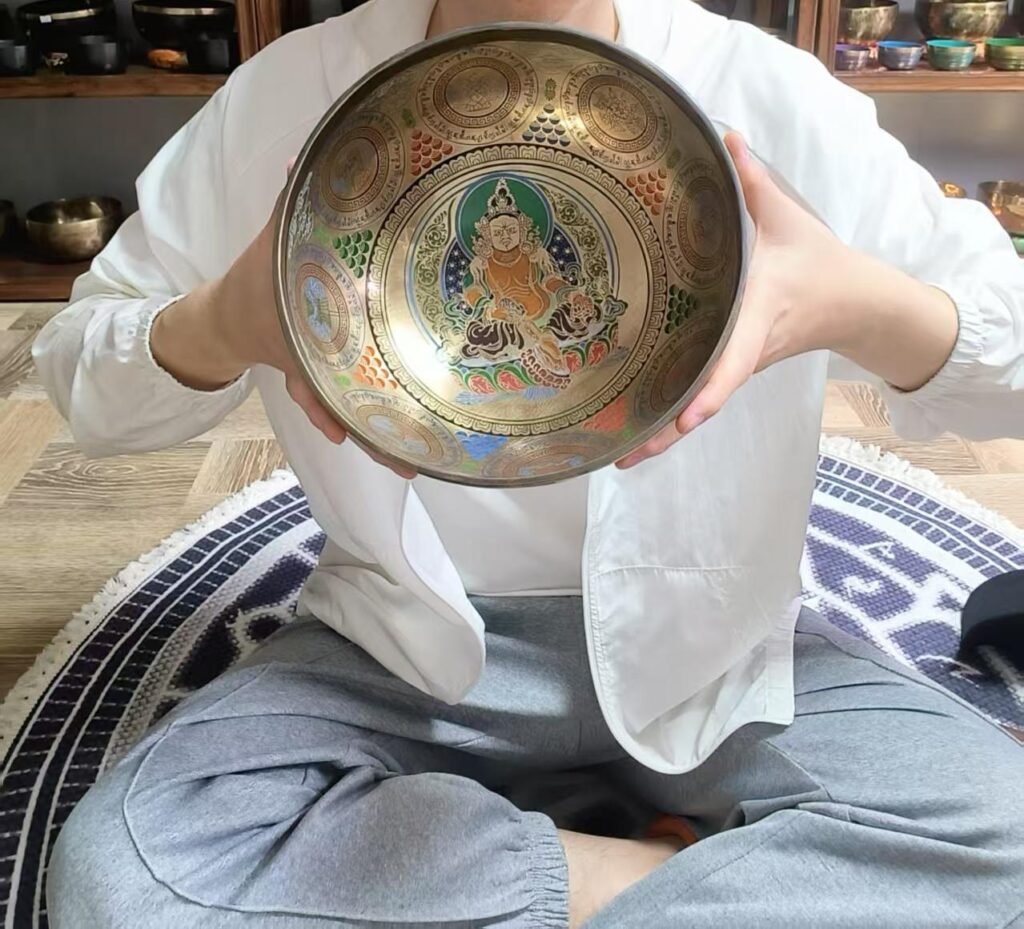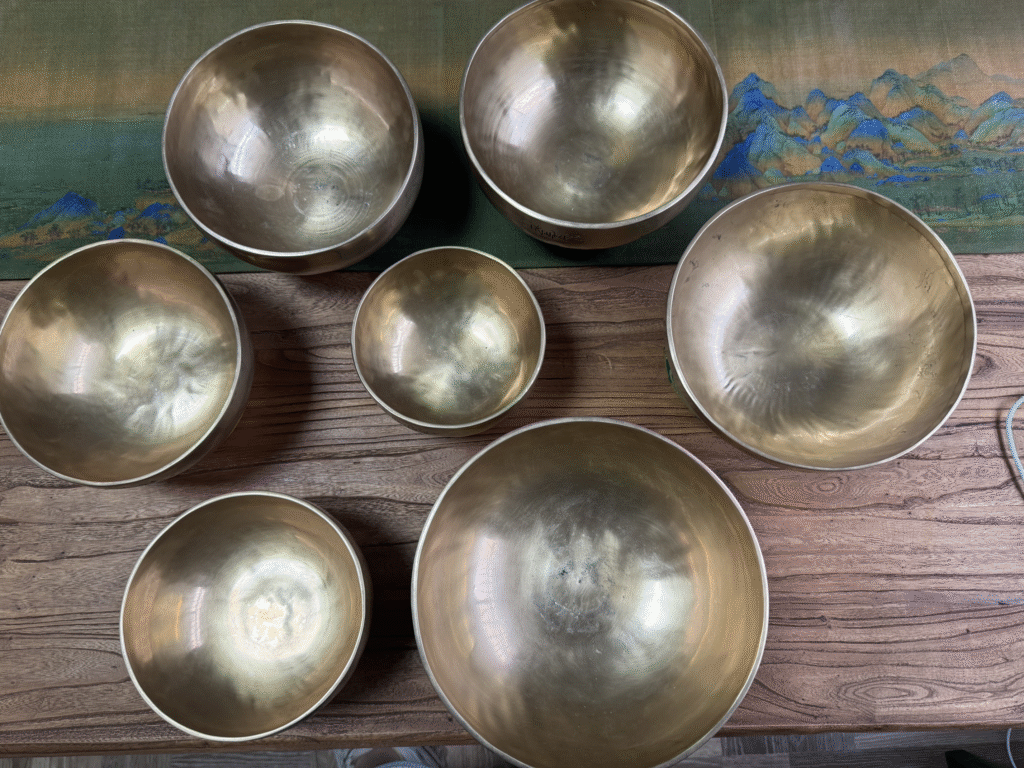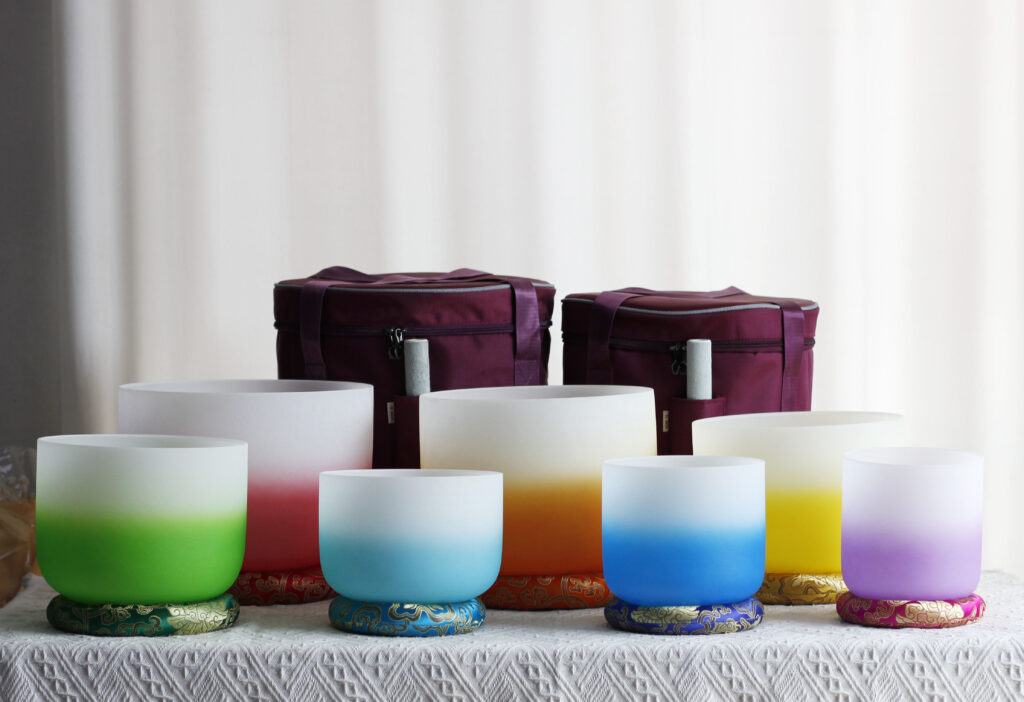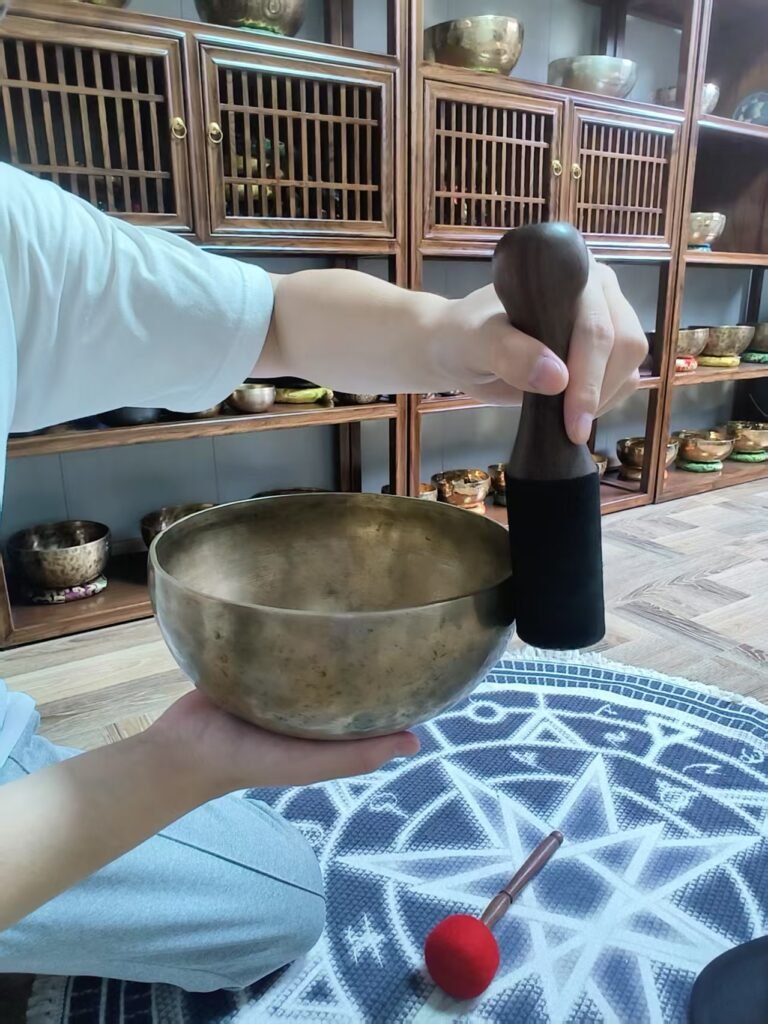Whether you’re drawn to singing bowls for personal meditation or considering them for professional sound healing practice, learning proper playing techniques is essential for unlocking their full potential. This comprehensive guide will walk you through everything you need to know about playing singing bowls effectively, from basic handling to advanced therapeutic applications.
What is a Singing Bowl? Understanding the Basics

A singing bowl represents far more than a simple musical instrument—it serves as a bridge between the physical and spiritual worlds, transforming ordinary bronze and crystal into gateways for profound healing experiences. When struck or circled with a mallet, these remarkable instruments produce rich, harmonic tones that seem to emerge from another dimension, creating sustained vibrations that promote relaxation, mental clarity, and spiritual awakening.
Originating from the Himalayan regions where ancient craftsmen understood the mystical properties of metal and sound, singing bowls have evolved from sacred monastery tools into cornerstone instruments for modern meditation, yoga, and sound therapy practices worldwide. Their unique acoustic properties create more than simple sound—they generate vibrational environments that can transform entire spaces and facilitate profound shifts in consciousness.
Traditional singing bowls carry within their bronze structure the accumulated wisdom of centuries, crafted from combinations of seven metals that ancient practitioners believed corresponded to celestial bodies in cosmic harmony. Gold representing the Sun, silver embodying the Moon, mercury channeling Mercury’s quick energy, copper reflecting Venus’s beauty, iron carrying Mars’s strength, tin channeling Jupiter’s expansion, and lead grounding Saturn’s wisdom—each metal contributes specific vibrational qualities to the bowl’s overall acoustic signature.
Modern manufacturing techniques have refined these instruments while maintaining their spiritual and therapeutic essence, creating instruments that honor traditional wisdom while meeting contemporary standards for consistency and acoustic excellence. Today’s singing bowls range from faithful reproductions of ancient designs to innovative contemporary interpretations that expand the possibilities for healing and spiritual practice.
The Science Behind Singing Bowl Therapy
Recent scientific studies validate what practitioners have experienced for centuries—singing bowl meditation can significantly reduce tension, anger, and fatigue while increasing spiritual well-being and promoting measurable physiological changes. The bowls produce frequencies ranging from one hundred ten to six hundred sixty hertz, which correspond precisely to brainwave states associated with deep relaxation, meditation, and healing.
When properly played, these instruments create binaural beats that help synchronize brain hemispheres and promote coherent states of consciousness conducive to healing and spiritual insight. The physics underlying these effects involves complex vibration patterns where the bowl’s walls oscillate in specific modes, creating standing wave patterns that produce the characteristic sustained tones capable of inducing profound therapeutic states.
The bowl’s shape, thickness, and material composition all contribute to its unique acoustic signature, with each element affecting how sound waves propagate through both air and human tissue. This scientific understanding helps explain why different bowls serve different therapeutic purposes and why proper technique proves so crucial for achieving desired results.
Types of Singing Bowls: Tibetan vs. Crystal vs. Brass
Understanding different types of singing bowls helps you make informed decisions about which instruments best suit your practice goals, budget constraints, and acoustic preferences.
Tibetan Singing Bowls

Traditional Tibetan bowls represent the pinnacle of hand-hammered metal craftsmanship, creating unique surface textures and tonal characteristics that make each instrument a one-of-a-kind creation. The hand-hammering process involves skilled artisans repeatedly striking heated metal with specialized tools, gradually shaping each bowl while creating the microscopic irregularities that contribute to complex harmonic overtones.
These organic imperfections actually create the rich, warm sound quality that distinguishes authentic hand-hammered bowls from machine-made alternatives. Each strike of the craftsman’s hammer leaves subtle variations in wall thickness and surface texture that affect how sound waves propagate, creating the complex frequency relationships that give traditional bowls their characteristic breathing, living quality.
Tibetan bowls typically range from three to twelve inches in diameter, with each size producing distinct frequency ranges spanning one hundred fifty to six hundred hertz. The fundamental frequencies provide grounding and centering effects, while the rich harmonic content extending into upper frequency ranges creates the complex acoustic environments that support deep meditation and therapeutic work.
The multiple overtones generated by quality Tibetan bowls create the characteristic beating effects that many practitioners find deeply relaxing and conducive to altered states of consciousness. These frequency interactions occur when slightly different frequencies combine, creating wave patterns that seem to breathe and pulse with organic rhythm.
Crystal Singing Bowls

Made from pure quartz crystal containing ninety-nine point nine percent silicon dioxide, crystal singing bowls produce crystalline tones that penetrate deeply into consciousness with unparalleled clarity and precision. The manufacturing process involves spinning quartz sand in high-temperature furnaces heated to over four thousand degrees Fahrenheit, creating instruments with extraordinary purity in both material composition and acoustic properties.
Crystal bowls typically appear larger and more fragile than their metal counterparts, but their acoustic capabilities often surpass traditional bowls in terms of volume, sustain duration, and frequency purity. The absence of metallic harmonics creates sounds that many practitioners find more direct and penetrating in their psychological and spiritual effects.
Clear crystal bowls produce bright, penetrating tones that cut through mental chatter and ambient noise with laser-like precision, making them particularly valuable for work requiring mental clarity and focused attention. Frosted crystal bowls feature textured surfaces created during manufacturing that soften the acoustic output, producing gentler tones that many find less intense and more suitable for group sessions or sensitive individuals.
The choice between clear and frosted crystal often depends on personal sensitivity to intensity and the specific applications intended. Clear bowls excel for individual practice focused on mental clarity and spiritual opening, while frosted alternatives prove more versatile for therapeutic work with diverse client populations.
Check how to choose crystal singing bowls
Brass and Bronze Bowls
Modern brass and bronze singing bowls offer excellent durability and consistent tonal quality through precision manufacturing techniques that ensure reliable performance for both beginners and professional practitioners. These instruments represent the marriage of traditional wisdom with contemporary metallurgy, creating accessible quality that serves diverse needs and budgets.
High-quality brass bowls typically contain sixty to seventy percent copper combined with thirty to forty percent zinc, creating alloys that balance acoustic properties with durability and cost-effectiveness. Bronze bowls incorporate higher copper percentages, usually seventy-eight to ninety-five percent copper with tin, producing warmer, more complex tones that approach the acoustic qualities of premium traditional instruments.
The specific alloy ratios significantly affect both durability and tonal characteristics, with higher copper content generally producing warmer, more complex sounds while zinc and tin additions enhance durability and consistency. Modern manufacturing enables precise control over these ratios, creating instruments with predictable acoustic properties that support both learning and professional application.
Essential Equipment: What You Need to Start Playing
To begin your singing bowl journey effectively, assembling the right equipment ensures both optimal sound quality and comfortable playing experience while protecting your investment in these valuable instruments.
Choosing the Right Singing Bowl
Your first bowl should typically measure between four and seven inches in diameter, offering the optimal balance between satisfying acoustic presence and manageable physical characteristics for learning fundamental techniques. This size range produces versatile tonal qualities suitable for exploring various playing methods while remaining light enough for comfortable handling during extended practice sessions.
Weight considerations become particularly important for beginners, with instruments ranging from one to three pounds providing adequate acoustic capability without causing fatigue that interferes with technique development. The manageable mass allows focus on proper striking and rim techniques while building the muscle memory and sensitivity needed for advanced playing.
Entry-level quality bowls starting around thirty to fifty dollars can provide satisfactory introduction to singing bowl practice, while mid-range options spanning sixty to one hundred twenty dollars often deliver excellent sound quality that supports skill development and long-term satisfaction. The investment in quality pays dividends through enhanced acoustic performance and durability that withstand the inevitable learning process.
Check our singing bowl: https://dorhymigroup.com/product-category/singing-bowl/
Strikers and Mallets
The striker serves as the crucial interface between player and bowl, fundamentally affecting both sound quality and playing technique. Understanding different striker materials and their applications enables informed choices that optimize acoustic results while supporting skill development.
Leather-wrapped strikers create warm, soft tones ideal for meditation and therapeutic applications where gentleness takes priority over precision. The leather compression during impact extends contact time with the bowl surface, producing gradual energy transfer that emphasizes fundamental frequencies while naturally filtering harsh overtones.
Felt-covered mallets produce cleaner, more defined sounds with excellent dynamic control, making them valuable for rhythmic playing and applications requiring precise volume control. The consistent density of quality felt provides predictable response across various playing intensities while maintaining durability through extended use.
Rubber strikers offer specialized capabilities for rim playing techniques, providing the consistent friction necessary for sustained tone production. Their grip characteristics enable smooth circular motion around the bowl’s rim while maintaining the contact pressure needed for continuous sound generation.
Size matching between striker and bowl proves crucial for optimal energy transfer and sound quality. Generally, the mallet’s diameter should approximate one-third to one-half the bowl’s diameter, ensuring adequate contact area for efficient energy transfer without overwhelming smaller instruments or proving inadequate for larger bowls.
Support Systems
Proper support systems allow bowls to vibrate freely while protecting them from damage and providing stable platforms for various playing techniques. The choice of support affects both acoustic performance and practical usability during extended sessions.
Silk cushions represent the traditional choice, offering elegant presentation combined with excellent vibration isolation that allows bowls to resonate without damping. The natural fiber construction provides appropriate density for support while maintaining aesthetic appeal that enhances the overall practice environment.
Rubber rings offer modern alternatives with excellent stability and vibration isolation, particularly valuable for mobile practitioners who need reliable support across various playing surfaces. Their durability and easy maintenance make them practical choices for frequent use and professional applications.
Wooden stands provide attractive display options that can double as playing platforms, though care must be taken to ensure adequate vibration isolation through appropriate cushioning. The aesthetic appeal of quality wood supports enhances practice environments while providing stable platforms for stationary playing techniques.
Step-by-Step Guide: How to Hold a Singing Bowl Properly
Proper holding technique forms the foundation for all effective singing bowl playing, affecting both sound quality and physical comfort during extended practice sessions.
For Hand-Held Playing
The fundamental hand-held position requires placing the bowl in your non-dominant hand’s palm, centering it carefully to achieve optimal balance that prevents tilting or instability during playing. The supporting hand should create a stable platform that allows the bowl to vibrate freely without dampening its natural resonance.
Keep your fingers extended straight beneath the bowl, forming a flat platform that supports the instrument’s weight while avoiding contact with the sides that could dampen vibrations. The finger position requires some practice to achieve comfort and stability, particularly during longer sessions where fatigue can compromise proper form.
Avoid gripping the bowl’s sides, as this contact immediately dampens the vibrations necessary for sustained tone production. Even light finger contact with the bowl’s walls can significantly reduce sustain duration and alter the acoustic characteristics, making proper hand position crucial for optimal results.
Hold the striker like a pencil in your dominant hand, maintaining a relaxed grip that allows fluid movement while providing adequate control for precise strikes. The grip should feel natural and comfortable, enabling both gentle touches and stronger impacts as technique demands vary.
Maintain relaxed posture throughout playing sessions, avoiding tension in shoulders, arms, or hands that can interfere with fluid movement and contribute to fatigue. Proper posture supports extended practice while enabling the natural movements that characterize skillful playing.
For Stationary Playing
Stationary playing offers advantages for extended sessions and techniques requiring precise control or multiple bowls. Place the bowl on a stable cushion or ring support that provides adequate vibration isolation while maintaining accessibility for various playing techniques.
Ensure the supporting surface doesn’t dampen vibrations through excessive contact or inappropriate materials. Hard surfaces without proper cushioning can alter acoustic properties, while overly soft supports may absorb too much vibrational energy.
Position yourself comfortably within arm’s reach of the bowl, allowing natural movement for both striking and rim techniques without strain or awkward positioning. The setup should support fluid motion while maintaining proper posture throughout extended sessions.
Keep the striker at approximately a forty-five-degree angle to the bowl’s rim, providing optimal contact geometry for both striking and rim playing techniques. This angle facilitates smooth transitions between different playing methods while ensuring efficient energy transfer.
The Striker Technique: Finding the Perfect Rhythm

Mastering striking technique provides the foundation for all singing bowl playing, establishing the fundamental skills that support both basic practice and advanced therapeutic applications.
Basic Striking Fundamentals
The perfect strike begins with gentle contact against the bowl’s exterior rim using controlled motion that neither forces nor hesitates. The initial impact should feel like a firm handshake—confident but not aggressive, with sufficient force to activate the bowl’s resonance without creating harsh or overwhelming sounds.
Follow-through proves crucial for optimal energy transfer, allowing the striker to bounce naturally off the bowl’s surface rather than remaining in contact or being pulled away abruptly. This natural rebound prevents dampening while ensuring clean energy transfer that promotes sustained resonance.
Listen carefully as each tone develops fully before striking again, allowing the complete acoustic evolution from initial attack through harmonic development to natural decay. This patience enables appreciation of the bowl’s complete voice while preventing the acoustic mudiness that results from overlapping strikes.
Maintain consistent timing between strikes to establish rhythm that supports meditative states rather than creating distraction. The spacing should feel organic and natural, neither rushed nor mechanically regular, allowing for the spontaneous expression that characterizes meaningful sound healing practice.
Force and Dynamics
Light strikes emphasize higher frequencies and create gentle tones suitable for sensitive applications, meditation work with beginners, or situations requiring subtle acoustic environments. The reduced impact energy naturally filters lower frequencies while bringing out the bowl’s brightest harmonic content.
Stronger strikes activate deeper fundamentals and more complex overtones, creating powerful sounds appropriate for group work, therapeutic applications requiring substantial acoustic presence, or personal practice focused on grounding and centering. The increased energy input activates more of the bowl’s vibrational modes, producing richer, more complex acoustic experiences.
Different rim areas produce varying tonal qualities that expand expressive possibilities. Rim strikes create the brightest, most penetrating tones with quick attack and shorter sustain, while upper wall strikes offer balanced tone quality with good sustain duration and moderate harmonic complexity.
Developing Consistent Technique
Practice with a metronome set to sixty beats per minute to develop consistent timing that becomes internalized over time. The external rhythm reference helps establish steady technique while building the internal sense of timing that supports advanced playing.
Focus on striking the same location with identical force to build muscle memory and reliable technique that produces predictable results. This consistency enables exploration of subtle variations while maintaining a solid foundation of basic competence.
Regular practice of fundamental techniques builds the physical coordination and sensitivity needed for advanced applications while developing the listening skills that distinguish skillful players from mere bowl strikers.
Rim Playing Method: Creating Continuous Tones
The rim technique produces the sustained, singing tones that give these instruments their name and create the continuous acoustic environments that support deep meditation and therapeutic work.
Fundamental Rim Technique
Begin by placing the striker against the bowl’s outer rim at its thickest section, typically near the top edge where the walls provide optimal mass for sustained vibration. This initial positioning proves crucial for successful rim playing, as inadequate contact area or improper placement prevents tone initiation.
Start with a gentle strike to establish initial vibration, providing the acoustic foundation upon which rim playing builds. This preparatory strike should produce a clear, sustained tone that demonstrates the bowl’s readiness for continuous playing.
Immediately transition to slow, circular motion around the rim, maintaining steady contact pressure throughout the movement. The key lies in consistent pressure application that neither increases nor decreases as the striker travels around the circumference.
Begin with minimal pressure and gradually increase as the tone develops, allowing the acoustic feedback to guide pressure adjustments. Too much initial pressure often prevents tone initiation, while insufficient pressure fails to maintain the friction necessary for continuous sound production.
Move slowly initially, completing one revolution every three to four seconds until the tone establishes clearly. Rushing this process represents the most common cause of rim playing failure, as rapid movement prevents the acoustic buildup necessary for sustained tones.
Critical Success Factors
The striker must maintain unbroken contact with the rim throughout the circular motion, as any gap in contact immediately breaks the acoustic chain that sustains continuous tone production. This consistent contact requires steady hand movement and appropriate pressure maintenance.
Speed control becomes crucial once tone initiation occurs, with optimal speed varying based on bowl size, striker material, and desired acoustic characteristics. Generally, slower movement produces richer, more sustained tones while faster movement creates brighter, more intense sounds.
Patience during the initiation phase often determines success or failure in rim playing. Many beginners abandon the technique too quickly, not allowing sufficient time for the acoustic buildup that characterizes successful rim playing.
Troubleshooting Rim Playing
Scratchy sounds typically indicate excessive pressure or worn mallet surfaces that create irregular friction patterns. Reducing pressure or replacing worn strikers usually resolves these acoustic problems while improving overall tone quality.
Tone breaks often result from inconsistent pressure or speed variations that disrupt the delicate friction balance necessary for sustained production. Practicing smooth, consistent motion with steady pressure builds the control needed for reliable performance.
Difficulty initiating tones usually stems from insufficient pressure, incorrect rim location, or inappropriate striker materials for the specific bowl. Experimenting with different pressure levels and rim positions often reveals the optimal technique for particular instruments.
Low volume typically requires gradually increasing pressure while ensuring full contact between striker and rim. The key lies in finding the pressure sweet spot that maximizes acoustic output without creating the excessive friction that produces harsh sounds.
Body Healing Techniques: Playing Bowls on Different Body Parts
Sound healing practitioners often employ direct body placement techniques that create focused therapeutic vibrations, requiring specific knowledge of safe application, appropriate frequencies, and proper protocols that prioritize client safety and comfort.
Safety Considerations and Contraindications
Before practicing bowl-on-body techniques, understanding important safety guidelines protects both practitioners and clients while ensuring effective therapeutic outcomes. Medical contraindications include pregnancy, particularly during the first trimester when developing fetal systems may be sensitive to vibrational input, and the presence of pacemakers or other cardiac devices that could be affected by acoustic vibrations.
Recent surgical sites require careful avoidance, as healing tissues may be disrupted by vibrational stimulation, while acute inflammation responds better to gentle indirect treatment rather than direct bowl placement. Areas with metal implants require special consideration, as the implants may resonate differently than surrounding tissue and create uncomfortable sensations.
General safety protocols include always obtaining clear verbal consent before placing bowls on clients, starting with very gentle strikes and gradually increasing intensity only when appropriate, and continuously monitoring client comfort and response throughout sessions. Keep cushions available to buffer vibrations if clients find direct contact too intense, and maintain brief initial sessions of five to ten minutes per body area until client tolerance is established.
Head and Neck Healing Techniques
Cranial bowl placement utilizes small to medium bowls ranging from four to six inches in diameter, positioned carefully on top of the head for mental clarity and stress relief. The lighter weight requirements, preferably under two pounds, prevent neck strain while providing adequate acoustic stimulation for therapeutic benefit.
Higher frequencies spanning three hundred to six hundred hertz prove most effective for mental stimulation and clarity work, while very gentle strikes spaced thirty to sixty seconds apart prevent overstimulation that could cause discomfort or headaches. Sessions should remain brief, typically five to ten minutes maximum, to avoid overwhelming the nervous system.
The benefits of cranial bowl work include enhanced focus, reduced mental fog, and increased spiritual connection, making this technique valuable for clients dealing with concentration difficulties, creative blocks, or spiritual seeking.
Forehead applications target the third eye chakra area using small bowls measuring three to four inches in diameter for comfortable positioning. Center placement on the forehead ensures stable contact while mid to high frequency ranges spanning four hundred to seven hundred hertz support clarity and intuitive development.
The gentle approach required for forehead work emphasizes soft strikes that avoid startling while providing sufficient stimulation for therapeutic benefit. Applications include meditation enhancement, intuitive development, and mental clarity work that supports decision-making and creative problem-solving.
Neck and shoulder tension relief requires careful indirect placement positioning bowls near rather than directly on the delicate neck structures. Shoulder applications using medium bowls on upper shoulder areas prove more appropriate for direct contact, while lower frequencies ranging from two hundred to four hundred hertz promote muscular relaxation.
Extended sessions lasting ten to fifteen minutes prove beneficial for chronic tension patterns, while gentle movement integration allows clients to explore range of motion while bowls provide vibrational support for muscle release.
Chest and Heart Healing Applications
Heart chakra work centers the chest area using medium-sized bowls positioned comfortably in the center of the chest, traditionally employing F note frequencies at three hundred forty-one hertz that correspond to heart chakra associations. The emotional release potential requires preparation for various emotional responses during treatment, as heart-centered work often accesses stored emotional material.
Coordinating strikes with the client’s natural breathing rhythm enhances therapeutic effectiveness while session lengths of ten to twenty minutes accommodate varying client sensitivity levels. The deep emotional access possible through heart chakra work makes this technique particularly valuable for clients dealing with grief, relationship issues, or emotional numbness.
Lung and respiratory support applications place small to medium bowls on the upper chest area using frequencies that support deeper breathing patterns and respiratory relaxation. The gentle vibrations may help relax chest muscles while providing anxiety relief for clients with respiratory-related anxiety.
Coordination with breath proves particularly important in respiratory work, with strikes timed during exhale phases for maximum therapeutic benefit and comfort.
Abdominal and Core Healing
Solar plexus chakra work utilizes medium bowls measuring six to seven inches in diameter to provide adequate coverage of the abdominal area. The traditional E note frequency at three hundred twenty hertz supports solar plexus activation while gentle vibrations may aid digestive function and emotional processing.
The solar plexus region holds significant emotional tension in many clients, making this area particularly responsive to vibrational therapy while requiring sensitivity to emotional releases that may occur during treatment. Client comfort considerations include ensuring comfortable positioning that avoids strain while providing effective therapeutic contact.
Lower abdominal applications focus on sacral chakra work using D note frequencies at two hundred eighty-eight hertz for creative and sexual energy activation. The gentle support for reproductive system health makes this technique valuable for clients dealing with fertility issues, creative blocks, or sexual dysfunction.
Lower back relief through indirect treatment provides vibrational support for chronic tension patterns while grounding effects from deep frequencies promote stability and security that support overall healing.
Limb and Extremity Healing
Arm and hand treatment places small bowls near arthritic or painful joints for circulation enhancement and relief of repetitive strain injuries like carpal tunnel syndrome. The focus on traditional meridian points along arms and hands draws from acupuncture theory while the mechanical vibrations may improve blood flow and reduce inflammation.
Leg and foot applications include knee placement using medium bowls for joint pain and stiffness relief, foot reflexology approaches using small bowls for whole-body treatment effects, and circulation improvement for clients with poor peripheral circulation. Grounding connection through foot placement provides earthing effects that support stability and security.
Back and Spine Healing Techniques
Spinal alignment support involves strategic bowl placement along the spine with clients lying face down, using sequential treatment patterns that move systematically up or down the spinal column. Frequency progression typically starts with lower frequencies and progresses higher, following traditional energy concepts about spinal chakra alignment.
Muscular relaxation focuses on areas of chronic tension and pain while energetic clearing addresses traditional beliefs about chakra alignment along the spinal column. The substantial coverage area requires larger bowls measuring eight to nine inches with deep frequencies spanning one hundred to two hundred fifty hertz for adequate muscular penetration.
Extended sessions lasting fifteen to twenty minutes accommodate chronic pain relief needs while heat generation from sustained vibrations may create warming sensations that enhance relaxation. Coordination with gentle movement allows clients to explore range of motion while receiving vibrational support.
Advanced Multi-Bowl Body Techniques
Full body sound bath applications involve strategic positioning of multiple bowls across the entire body using frequency mapping that assigns different frequencies to different body areas. Sequential activation follows systematic striking patterns across all bowls while harmonic relationships between bowls create complementary frequency interactions.
Session durations spanning thirty to sixty minutes provide complete treatment experiences while chakra system balancing uses seven-bowl systems with one instrument for each major chakra. Progressive treatment approaches start at the root chakra and move to crown, or vice versa, while integration phases involve all bowls sounding together for system harmony.
Client assessment throughout multi-bowl sessions monitors energy shifts and responses while professional protocol development structures sessions through client consultation, preparation phases, progressive application, and integration time with feedback discussion.
Common Beginner Mistakes and How to Avoid Them
Understanding common errors helps beginners avoid frustrating problems that interfere with learning while developing proper habits from the start.
Mistake 1: Gripping the Bowl Incorrectly
The most frequent beginner error involves gripping the bowl’s sides, which immediately dampens vibrations and reduces sustain duration dramatically. Practice the platform hold with fingers extended flat beneath the bowl, starting with smaller instruments to build confidence before progressing to larger, heavier bowls.
Mistake 2: Using Too Much Force
Beginning enthusiasm often leads to excessive striking force that creates harsh sounds and potential damage to instruments. Start with the gentlest touch that produces audible sound and focus on tone quality rather than volume, gradually increasing force only as technique and listening skills develop.
Mistake 3: Moving Too Fast Around the Rim
Rim playing failure usually results from attempting to move too quickly around the circumference before tone establishment occurs. Use a metronome set to forty to sixty beats per minute for timing reference and remember that slower movements consistently produce richer, more sustained tones.
Mistake 4: Playing on Sound-Dampening Surfaces
Inappropriate surface selection can dramatically reduce acoustic performance and sustain duration. Use hard, stable surfaces with proper cushions designed specifically for singing bowls, avoiding soft furniture or carpeted areas that absorb vibrational energy.
Mistake 5: Rushing Body Healing Applications
The powerful effects possible through body placement techniques require gradual, careful introduction rather than immediate intensive application. Always start with indirect placement and very gentle techniques, building intensity gradually based on clear client comfort and positive response indicators.
Sound Quality Factors: Bowl Size, Material, and Thickness
Understanding what influences sound production helps optimize technique while making informed decisions about instrument selection and playing approaches.
Size Impact on Sound
Small bowls measuring three to five inches produce higher frequencies ranging from four hundred to eight hundred hertz, creating bright tones with excellent portability that suit travel practice and precision work. Medium bowls spanning six to eight inches generate balanced frequencies from two hundred to five hundred hertz with versatile applications for most practice needs.
Large bowls exceeding nine inches create deep frequencies spanning one hundred to three hundred hertz with powerful room-filling capabilities that serve group work and therapeutic applications requiring substantial acoustic presence.
Material Effects
Bronze alloys produce warm, rich tones with complex harmonic development that supports deep meditation and therapeutic work, while brass alloys create bright, crisp sounds with consistent quality that proves excellent for learning and general practice. Crystal construction generates pure tones with minimal harmonic distortion that penetrates deeply into consciousness with laser-like precision.
Quality Indicators
High-quality instruments sustain tones for forty-five seconds or more while maintaining clear harmonic separation throughout the decay period. Consistent response across various playing techniques indicates superior construction, while frequency stability across temperature changes demonstrates quality materials and craftsmanship.
Meditation Techniques with Singing Bowls
Basic Meditation Practice
Single-tone focus meditation begins with comfortable seating with your bowl within easy reach, followed by three deep breaths to establish centered awareness. Strike the bowl gently and focus completely on the resulting sound, following the tone from initial attack through complete fade while resting in silence after the tone disappears.
Repeat the process when ready while maintaining continuous awareness throughout the practice, allowing gaps between strikes to extend naturally rather than forcing regular timing.
Chakra Balancing
Many practitioners employ different bowl sizes for systematic chakra work, using large, deep bowls around two hundred fifty-six hertz for root chakra grounding, medium bowls at three hundred forty-one hertz for heart chakra emotional balance, and small, high bowls near four hundred eighty hertz for crown chakra spiritual connection.
The progression through the chakra system typically follows either ascending or descending patterns, with integration periods allowing the complete energetic system to achieve harmony and balance.
Group Meditation Leadership
Leading group meditation sessions requires larger bowls for adequate room coverage, longer pauses between strikes to accommodate group processing time, and careful attention to group energy levels that guide playing adjustments. The acoustic presence must reach all participants equally while maintaining appropriate volume levels for the space and group size.
Maintenance and Care: Keeping Your Bowl in Perfect Condition
Daily Care
After each use, wipe bowls with soft, dry cloths to remove fingerprints and moisture that could affect appearance and longevity. Handle instruments with clean, dry hands and store in consistent temperature conditions that prevent thermal stress and material degradation.
Deep Cleaning
Metal bowls tolerate warm water and mild soap applications, but require thorough rinsing and immediate drying to prevent water spots and oxidation. Apply appropriate metal polish sparingly when needed, following manufacturer recommendations for specific alloy types.
Crystal bowls require more delicate care with lukewarm water only, as extreme temperatures can cause cracking. Use gentle soap with soft cloths and pat dry carefully to avoid applying stress to the crystal structure.
Storage Solutions
Daily use storage should maintain bowls on cushioned surfaces that allow free vibration while protecting from damage. Long-term storage requires foam-lined cases with climate control to prevent temperature and humidity fluctuations that could affect materials and acoustic properties.
Separate different bowl types to prevent contact damage, particularly protecting delicate crystal instruments from harder metal bowls that could cause chips or cracks.
Choosing the Right Singing Bowl for Your Needs
For Personal Meditation
A medium-sized bowl measuring six to seven inches offers optimal versatility and portability while producing rich, satisfying tones suitable for daily practice development. Budget allocation around fifty to one hundred fifty dollars typically provides excellent quality instruments that support years of meaningful practice.
For Sound Therapy Practice
Professional applications require comprehensive sets of three to seven bowls covering different frequency ranges to address diverse client needs. Hand-crafted instruments often prove preferable for their unique tonal characteristics and individual acoustic personalities, with investment ranges spanning two hundred to eight hundred dollars for complete therapeutic setups.
For Body Healing Work
Select instruments based on intended body applications, with small bowls for head, neck, and extremity work, medium bowls for chest, abdomen, and general applications, and large bowls for back, legs, and full-body treatments. The size and frequency characteristics must match the anatomical areas and therapeutic goals for optimal effectiveness.
For Beginners
Starting with a high-quality brass or bronze bowl from reputable manufacturers provides excellent learning characteristics while maintaining long-term value. Focus on sound quality and craftsmanship rather than lowest price, as instruments in the sixty to one hundred twenty dollar range often provide superior learning experiences that support continued development.
Conclusion
Mastering singing bowl playing requires patience, consistent practice, and quality instruments that respond to developing technique with satisfying acoustic results. Whether seeking personal meditation enhancement or professional sound therapy skills, these techniques help unlock the full potential of these remarkable instruments while honoring their cultural heritage and therapeutic traditions.
When incorporating body healing techniques, always prioritize client safety and comfort through gentle introduction, careful monitoring, and gradual progression that respects individual sensitivity and response patterns. Professional development requires proper training, appropriate insurance, and ongoing education that maintains high standards for ethical practice.
Quality singing bowls represent investments in both personal growth and cultural preservation. By choosing appropriate instruments and maintaining high technical standards, practitioners contribute to preserving valuable healing traditions while ensuring positive experiences with these extraordinary tools for transformation, healing, and spiritual development that continue serving humanity across cultures and generations.
Take time to develop proper technique gradually, allowing your relationship with these instruments to deepen naturally through consistent practice and respectful approach. Your singing bowl journey will reward patience and dedication with years of meaningful practice that supports whatever path toward greater awareness, healing, and inner peace you choose to follow.








One Response